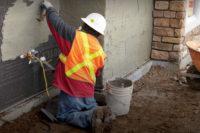
To understand the complete system or the whole story so to speak, look at the total system. This system includes metal lath accessories that hold the system together, gives it strength and durability in critical areas, and makes it more architecturally attractive. These accessories are to be the basis of this article.
Metal lath is used as a platform to embed and attach the stucco cementitious membrane to the structural members of the building. Without the lath there would be little or no way to apply stucco to open frame or sheathed construction. While the above statement is true, it is the accessories such as foundation weep screeds, corner beads, casing beads and expansion joints that finish the basic lath system and reveals, soffit vents and banding beads that allow for buildings to breathe and look appealing. The best way to look at accessories is to look first at the basic core accessories that would normally be found on even the most basic stucco application.

They come in threes
Most accessories are available in three types of materials: galvanized zinc-coated steel, zinc alloy (99 percent pure zinc) and PVC vinyl. Some accessories are also available in anodized aluminum extrusions. An entire article could be devoted to the best material for various conditions, but suffice it to say that if rust is a problem in some regions due to salt air, high humidity, or industrial pollution, use vinyl or zinc alloy accessories should be used.

Casing beads should also be installed over moisture barriers or flashing. As Image 3 shows, these beads have a “J” type configuration and are most commonly provided with an expanded flange to allow complete embedment of the stucco and lath. This embedment will join the two into a single cohesive unit. Attachment is accomplished by nailing, stapling or screwing the bead to the framing, or through the sheathing into the framing at a spacing not to exceed 7 inches on center.

The next step
Once the two previous beads are in place, the metal lath is installed. This is followed by the installation of the last two primary accessories, corner bead and expansion joints. Expanded flange corner beads (Image 4) usually have 3-inch expanded flanges with a rounded solid metal or vinyl nose that partially remains exposed after the stucco application. Some contractors prefer to use corner reinforcement that is completely buried in the stucco. This will not be discussed here but is an acceptable option. The angle on this bead is approximately 90 degrees with the expanded flanges facing each other. Some manufacturers provide corner beads that can be joined with a section of wire or small nails to make a smooth transition from one section to the next. Since the corner of the stucco membrane is often susceptible to damage from being struck, the corner bead adds reinforcement to this critical area and the metal bead will take some abuse in order to protect the Portland cement. It is imperative that the entire bead be filled with stucco in order to provide the strongest corner possible. Hollow corner beads will soon fail due to delamination.
The final primary accessories to be installed are the control/expansion joints. ASTM C1063, the metal lath installation specification for Portland cement, does not differentiate between control and expansion joints. However, most industry experts consider one-piece joints to be control joints and two-piece joints including double casing beads, to be expansion joints. Generally, the two-piece joint (Image 6) can be expected to deal with larger amounts of expansion such as at through wall expansions, a change in building materials such as where a block wall meets a framed wall or at floor lines. For the purpose of this article, only the one-piece control joint will be discussed.
The one-piece control/expansion joint (Image 5) is used in more than 90 percent of the control joint applications in North America. This joint may be called by many names including the “M” or type expansion, the #15 type, the control joint, the “J” type expansion and so on. Although there are many variations of this product, they all function in much the same fashion. Most have a pair of expanded or perforated flanges flanking an accordion shaped expansion mechanism. This mechanism will accommodate the opening and closing of the joint expected from normal stucco shrinkage during hydration and curing, and small amounts of movement from thermal expansion and contraction. The proper use of expansion or control joints will not guarantee that stucco will not crack but it does reduce the odds and severity of minor cracking due to normal stress. Structural movement caused by deflection beyond what stucco is designed to handle, building settlement, shrinkage of wet green lumber and seismic events will often cause structural cracks to occur. These are all circumstances that exceed what the stucco membrane can be expected to accommodate without cracking.
Expansion/control joints are installed over the metal lath. The lath must be cut or discontinuous behind the joint and wire tied on both sides of the cut. The wire ties must be spaced no more than 7 inches on center along the entire bead. Many contractors accomplish this procedure by popping a caulk line at the location of the joint, and using hand or electric shears to cut the lath behind the joint. Joint locations should occur within 3 inches of a structural support. During and after plastering, the joint must be cleaned to ensure that no stucco or finish material remains in the joint. This material will impede the proper functioning of the joint. Control joints are required to form panels that do not exceed 144 square feet for walls and 100 square feet for ceiling applications. Furthermore, a maximum length-to-width ratio of 2 1/2 to 1 is required and no single dimension can exceed 18 feet in length. Vertical joints must be continuous at intersections of joints and horizontal joints should be broken. All junctures of all beads should be embedded in a good flexible caulk to resist water intrusion.
Expansion/control joints are likely the most controversial accessories used in the lath assembly. Some industry experts have been quoted as saying that they are not needed at all, some say that cutting the lath and wire tying is a waste of time, and some strongly believe that they must be installed at proper intervals and installed properly in order for the stucco system to have any chance of success.
Stucco is better and more popular today than it has been in decades. The proper selection and use of lath accessories will complete the job and help to ensure that this system will function properly for generations.





